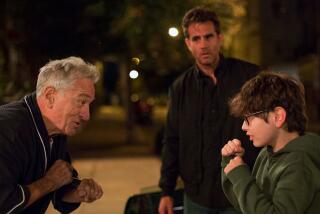MOVIE REVIEW : ‘Zed’ Comes to Naught in Style
- Share via
Anyone coming to Peter Greenaway’s “A Zed and Two Noughts” (the Ken in San Diego tonight and Friday) after unreservedly enjoying his 1982 “The Draughtsman’s Contract” may feel a few qualms.
Greenaway’s debut feature was a viciously elegant pastiche Restoration comedy, a painterly variation on Antonioni’s “Blowup.” But where “Draughtsman” dazzled you with its tight design and cold irony, “A Zed and Two Noughts” sometimes seems to swim in a stew of affectations and preposterous conceits, its exquisitely composed frames peopled with maniacally posturing ciphers cracking passionless jokes.
“Zed” takes place in or near the Rotterdam Zoo, source of the film’s punning title. There, a jarringly symbolic plot commences, after a swan-and-car collision that leaves two women dead and one, Alba Bewick (Andrea Ferreol), an amputee.
Mirror-against-mirror metaphors descend. The collision makes widowers of twins Oswald and Oliver (Brian and Eric Deacon) and plunges them into a tri-corner affair with one-legged Alba--who becomes pregnant by the twins in lavishly doubled and symmetrical purple-pink rooms. We can guess what we’re in for: a rumination on life, love, bad sex, doubling, man’s mistreatment of animals, artifice vs. the life force and the inevitability of birth, death and decay.
Wandering through this stunningly decorated disquisition--you could scarcely call it a drama or comedy--are a prostitute named Venus de Milo, who works near the panda house; a sadistic surgeon, Van Meegeren (Gerard Thoolen); his exhibitionist assistant and a set of sinister zoo employees who seem to have drifted in from a parody of Graham Greene. TV monitors everywhere bombard us with David Attenborough’s BBC documentary “Life on Earth.” The plot doesn’t unfold, it decays; much like the putrefying animal corpses that Oswald and Oliver obsessively record with time-lapse photography.
If this sounds labored or unpleasant, it’s only partly so. Greenaway’s jokes and ideas tend to bounce off at weird angles, but his high visual skills, enhanced by cameraman Sacha Vierny (“Belle de Jour”), produce so many remarkably composed and lit frames that the film is a joy to behold. Their model is Vermeer, and they often capture some of that 17th-Century Dutch painter’s eerie tranquility, stillness and perfectly balanced depth: the checkerboarded floors, sumptuously hanging drapes, the strange, thick light.
But there’s a sour edge. You don’t expect a humanistic portrayal of the amputee’s plight from a movie like this, but there’s something awry when your main response to Alba is curiosity about where her legs are tucked away. And though Greenaway claims to be uninterested in conventional stories, the story here has a sentimental core that sabotages it.
Oswald and Oliver are passive characters, anesthetized by self-pity. They’re unengaging even when they truck around in a double-breasted suit that makes them look like a two-headed David Byrne.
More to Read
Only good movies
Get the Indie Focus newsletter, Mark Olsen's weekly guide to the world of cinema.
You may occasionally receive promotional content from the Los Angeles Times.










